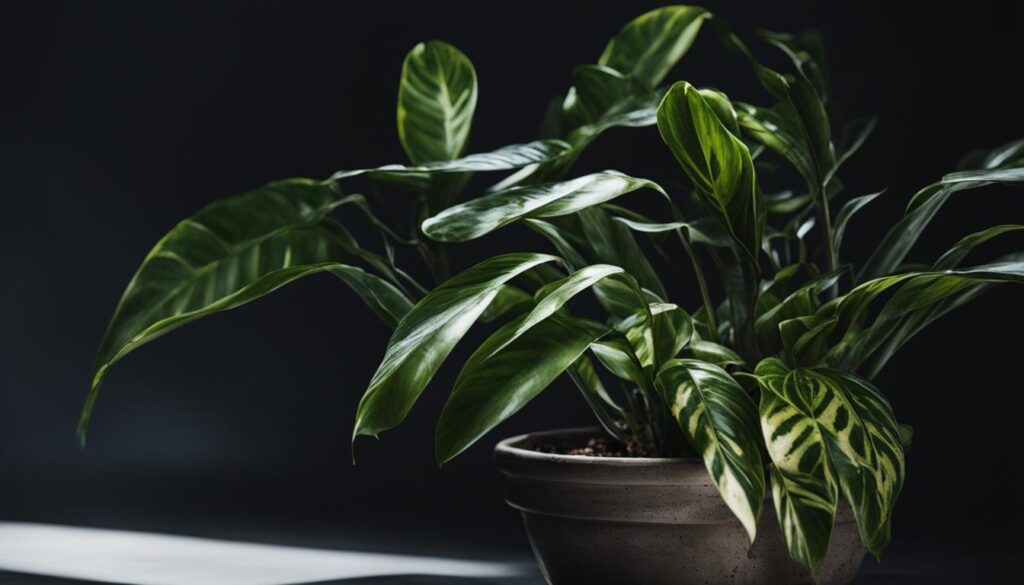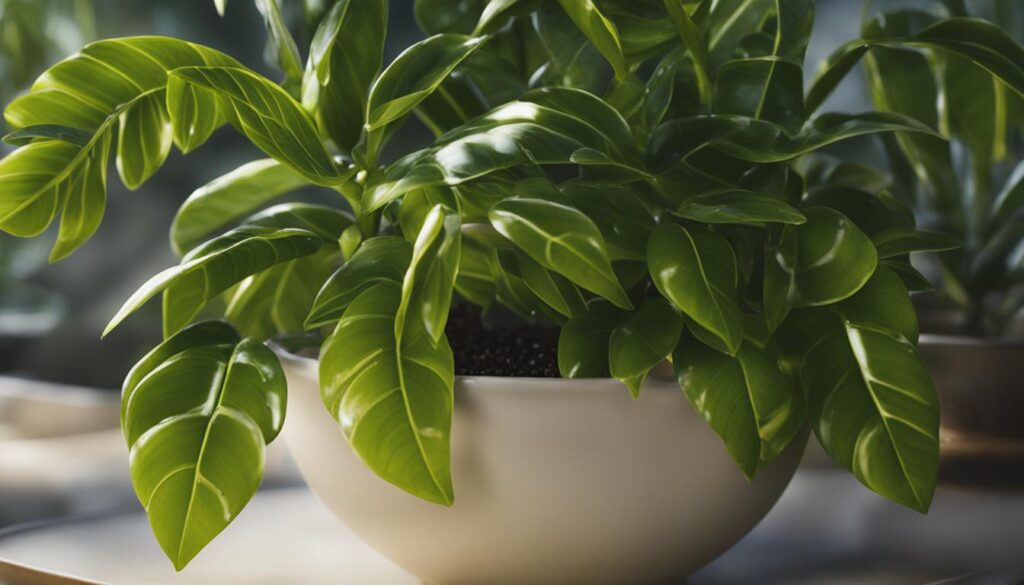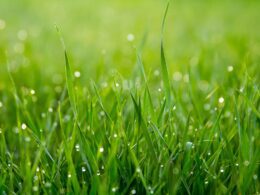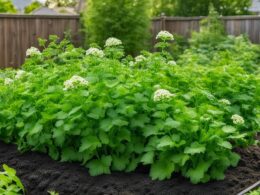When faced with ZZ plant yellow leaves, many indoor gardeners panic, uncertain of how to resolve the issue. However, identifying and addressing ZZ plant problems is often straightforward once you know the common reasons for this discolored foliage. By learning about the primary causes and implementing effective care strategies, you can work towards restoring ZZ plant health and reinvigorating your beloved indoor plant. This guide will discuss topics such as root rot in ZZ plants, the importance of repotting houseplants when necessary, and practical steps for aiding in ZZ plant recovery and preventing plant chlorosis.
Key Takeaways
- Yellowing leaves in ZZ plants often signal improper care, such as overwatering or inadequate light exposure.
- Root rot is a common culprit behind yellow leaves, and damaged roots should be removed during repotting for recovery.
- Establishing proper watering and lighting conditions is essential to maintaining ZZ plant health and preventing yellowing leaves.
- Self-watering planters can help regulate soil moisture levels and prevent over or underwatering.
- Pests and diseases can also cause yellow leaves, so providing optimal care and implementing preventive measures are crucial for long-term ZZ plant health.
Decoding the Yellow Warning Signs on Your ZZ Plant
Overwatering: The Chief Culprit in ZZ Plant Distress
One of the primary reasons for yellow leaves in a ZZ plant is overwatering. Excess water can lead to root rot symptoms, with the soil remaining damp for long periods. When overwatered, roots struggle to access necessary oxygen, causing stress and decay. To fix overwatering and maintain ZZ plant leaf health, first investigate the potting soil. If overly saturated, allow the soil to dry, then introduce better drainage to prevent future water accumulation.
- Check for damp and compacted soil.
- Allow soil to dry before watering again.
- Improve drainage by adding perlite or sand to the soil mix.
Underwatering: Silent Sabotage
Underwatering can also cause yellowing and wilting leaves in a ZZ plant. These plants require a consistent moisture level to maintain healthy foliage. To strike the right soil moisture balance, establish a regular watering routine that allows the soil to partially dry out (but not completely) between waterings.
- Monitor soil moisture regularly.
- Apply dry soil remedies as needed.
- Water deeply and evenly to reach all roots.
Too Much Love: The Hazard of Overfertilization
Overfertilization can damage ZZ plants, leading to nutrient burn and yellow leaves. Ensuring a balanced ZZ plant fertilization approach is crucial to prevent these issues. Avoid applying fertilizer too frequently or in high concentrations, as this may lead to overfertilization signs and damage the plant. By correcting fertilizer issues and adopting a more balanced plant care routine, you can restore your ZZ plant’s vigor and health.
| Issue | Solution |
|---|---|
| Nutrient Burn | Reduce fertilizer concentration or frequency. |
| Overfertilization | Dilute fertilizer and adjust application schedule. |
| Imbalanced Nutrition | Use a balanced, slow-release fertilizer. |
By addressing these common care missteps, you can ensure a healthy, vibrant ZZ plant that displays lush green leaves instead of yellow, damaged foliage.
Recovery Tactics for Overwatered ZZ Plants
Saving overwatered ZZ plants requires a multifaceted approach that tackles the issue of root rot and helps restore a healthy balance in your plant’s care routine. Follow these effective steps to ensure the optimal plant care after overwatering and to facilitate root rot recovery.
- Let the soil dry out: Reduce the moisture content of the soil by withholding water, ensuring the roots have time to breathe and heal.
- Remove damaged roots: Carefully examine the plant’s root system and prune away any brown, soggy, or decaying roots. This will promote a healthy ZZ plant revival.
- Repot in fresh, well-draining soil: Transfer your ZZ plant to a clean pot with fresh soil that allows excess water to drain easily, preventing future overwatering issues.
Post-recovery, establishing a proper watering schedule is crucial in maintaining a healthy ZZ plant. Observe the following guidelines to prevent recurrence:
- Check soil moisture levels: Test the top 1-2 inches of the soil with your finger to determine if it’s time to water. If it feels dry, proceed with watering.
- Water deeply: When watering, saturate the soil thoroughly, allowing water to drain out of the bottom of the pot. Remember to discard any excess water that collects in the saucer.
- Adjust your watering routine: Pay attention to changes in temperature and humidity that may affect your plant’s moisture needs. Adapt your watering habits accordingly to maintain a healthy balance.
Maintaining a watchful eye on your ZZ plant and ensuring proper care after overwatering will lead to a successful recovery and a thriving plant.
Setting the Right Watering Schedule for Your ZZ Plant
Establishing a balanced watering schedule is essential to maintain the moisture requirements of ZZ plants and prevent yellowing leaves. Given their unique ZZ plant watering needs, it is crucial first to understand the soil dryness before watering to avoid over or underwatering. This will ensure proper plant hydration and robust growth.
Understanding ZZ Plant’s Thirst
Adopting a deep watering method enables you to maintain consistent soil moisture levels for your ZZ plant. To do this, water the plant until the water drains from the bottom of the pot and then discard any excess sitting in the saucer. Following this technique will cater to the plant’s hydration needs and encourage healthier foliage. However, it is essential to allow the soil to dry slightly between waterings to prevent overwatering, which can lead to root rot and yellowing leaves.
| Watering Schedule | Signs of Proper Moisture Level | Signs of Overwatering | Signs of Underwatering |
|---|---|---|---|
|
|
|
|
Self-Watering Planters: A Smart Solution
For busy plant owners or those who require low-maintenance plant care, utilizing ZZ plant self-watering planters can be a game-changer. These planters are designed to deliver steady hydration and regulate the moisture your ZZ plant receives, thus preventing common watering pitfalls. Self-watering planters are particularly beneficial for maintaining the right moisture levels when you are away from home or often forget to water your plants, as they offer smart watering solutions that takes the guesswork out of proper plant hydration.
Ensuring Proper Light Conditions for Healthy Green Leaves
Getting the right amount of light is essential to prevent yellowing leaves in ZZ plants. To meet your ZZ plant lighting needs, provide bright, indirect sunlight. This ensures adequate sunlight for plant growth while preventing leaf burn that can result from prolonged exposure to direct sun.
ZZ plants can adapt to low-light conditions, making them a versatile indoor plant choice for spaces with limited sunlight. However, it’s crucial to ensure that they still receive some indirect light to maintain their health and prevent yellowing issues. For optimal results, here are some tips to help you manage your ZZ plant’s light exposure:
- Place your ZZ plant near a window with filtered sunlight, such as through sheer curtains, to provide the right balance of light without causing leaf burn.
- Avoid exposure to intense afternoon sun, as this can cause damage to the plant’s leaves. Instead, morning sunlight is an excellent choice for providing the necessary ZZ plant light exposure without causing harm.
- Rotate your plant periodically to ensure even exposure to light, promoting balanced growth and healthier foliage.
- If you live in an area with limited natural light, consider using a grow light to give your ZZ plant the light it requires. These artificial light sources can help replicate the conditions it needs to thrive.
By catering to your ZZ plant’s lighting needs, you can ensure bright, healthy green leaves and promote overall plant growth. Proper light conditions can make all the difference in maintaining the beauty and vitality of your ZZ plant, allowing it to remain an eye-catching indoor plant for years to come.
Combatting Pests and Diseases
Your ZZ plant can attract various pests and diseases, especially when it is stressed or weak. Understanding how to identify and treat these infestations is essential to maintaining plant health and preventing damage. By adopting organic pest control methods and preventive practices, you can protect your ZZ plant from harm.
Identifying Common Pests on a ZZ Plant
Sap-sucking pests, such as spider mites, mealybugs, and scale insects may infest ZZ plants when they are under stress. Signs of infestation include yellowing leaves, visible bugs, and webbing on the leaves and stems. To control the problem and prevent damage, isolate the affected plant and treat it with appropriate pest control methods.
Effective Organic Treatments
For an environmentally friendly approach to treating infestations on your ZZ plant, consider using natural remedies like neem oil or insecticidal soap. These organic treatments effectively combat pests without introducing harsh chemicals, thereby maintaining plant health and minimizing the impact on the environment:
- Neem oil: Can be used as a spray or applied directly to the plant to deter pests and prevent future infestations.
- Insecticidal soap: A diluted solution of soap can be sprayed on the leaves and stems, effectively killing pests upon contact while being gentle on the plant.
Preventive Measures Against Plant Diseases
To prevent diseases in your ZZ plant, adopt protective care strategies and optimize plant health by following these guidelines:
- Ensure good air circulation around the plant to reduce the likelihood of disease and pest infestations.
- Use clean pots and tools to minimize the risk of introducing pathogens to your plant.
- Avoid overwatering, which can cause root rot and make the plant more susceptible to diseases.
- Regularly inspect your plant for early signs of stress or infestation, and take corrective action promptly.
By providing optimal growing conditions and adhering to proper plant care practices, you can help your ZZ plant resist pathogens and maintain its overall health and vigor.
– Will Over-Fertilizing My Zz Plant Cause Its Leaves to Turn Yellow?
Over-fertilizing your ZZ plant can indeed cause its leaves to turn yellow. It’s crucial to maintain the proper fertilizing ZZ plant frequency to avoid nutrient buildup, which can lead to leaf discoloration. Stick to a consistent fertilizing schedule to keep your ZZ plant healthy and vibrant.
Conclusion
Dealing with ZZ plant yellow leaves can be a frustrating challenge, but by identifying the root cause, you can effectively restore and maintain the health of your cherished foliage. Common issues related to watering, lighting, pests, and fertilization often contribute to this problem. Fortunately, most of these issues can be easily resolved with proper plant care techniques and adjustments to your routines.
Pay close attention to your ZZ plant’s light exposure, watering schedule, and fertilization to prevent the occurrence or recurrence of yellowing leaves. Implementing effective, organic pest control methods can help minimize infestations and keep your plant healthy and productive. Practicing preemptive care and understanding your plant’s unique needs and requirements will enable you to foster a thriving, robust ZZ plant.
In conclusion, yellow leaves in ZZ plants serve as a warning sign that your plant needs attention and care. By consistently monitoring and adjusting your ZZ plant’s care, you can ensure its overall health and vitality, helping it to flourish and showcase the vibrant green foliage it is known for. Remember, the key to success in keeping a healthy, lush ZZ plant is to follow effective plant care tips tailored to its specific needs and preferences.











